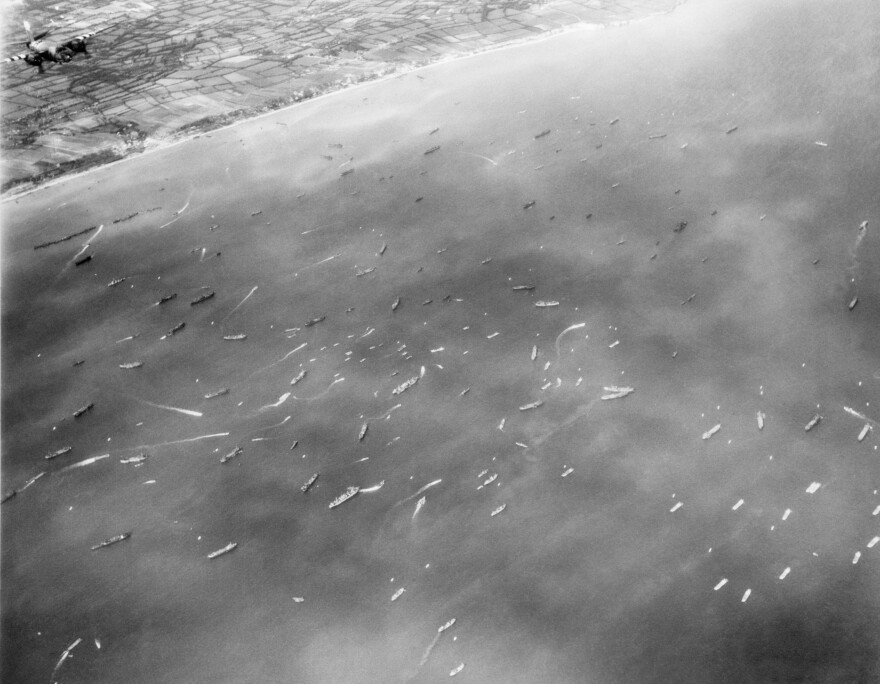This is part of a special series where NPR looks back at our coverage of major news stories in the past.
Frank Walk was in a hurry.
The U.S. Army captain had been ordered to bring top-secret planning documents to Gen. Dwight D. Eisenhower's headquarters, which at the time was a 19th-century manor near Portsmouth, England. It was just before the Allied invasion of Nazi-occupied Normandy, France, on June 6, 1944.
Walk said he remembered a speedy, cross-country jeep ride to make his delivery.
"That was a pretty hairy ordeal, and all the time, I was afraid that I wasn't going to get back to our staging area in time to board the ship for the crossing," he told NPR's Talk of the Nation in 2004. Later, Walk said, he wished he'd missed the trip.
He was one of more than 150,000 U.S., British and Canadian troops who stormed the Normandy beaches on D-Day — and one of a handful who in the decades after told NPR about their experience. The invasion was the largest amphibious assault in history, and a crucial turning point in World War II.
More than 6,000 ships and landing craft crossed the English Channel in the mission. Before dawn, Allied gliders and paratroopers dropped behind enemy lines. There were more than 11,000 planes, including bombers that sought to weaken the so-called Atlantic Wall of German defenses.
Jim McLaughlin had a front-row seat: the top turret of a B-26 bomber.
"I couldn't believe that there were that many ships in the whole world — all headed in the same direction," he told NPR in 1994. "And then a few moments later to see that beach."

Hitting the sand
Troops crowded into small, narrow landing craft, designed to hold about three dozen men in an area smaller than a parking space. Walk, a combat engineer tasked with clearing Nazi fortifications, was caught in strong winds and rough seas.
"We had a hard time getting into the boat in the first place. It was bouncing around, waves blowing over the side. Wasn't long before all of us aboard that little boat were seasick," he said. "Then we began to say, 'Gee, when can we get to shore?' "
"Again, when we got there, we wished we weren't there," Walk added.
Allied troops landed at five beachheads along a 50-mile stretch of coastline. The beaches were codenamed Utah, Omaha, Gold, Juno and Sword. Cpl. William Dabney served with the First Army's 320th Anti-Aircraft Barrage Balloon Battalion, an all-Black unit.
"We saw guys crying, we saw guys after they got off, they [were] throwing up," he said. "Everybody was scared to death. But you did what you had to do. You tried to protect yourself and save your life."
Soldiers charged head on into Nazi gunfire, landmines and barbed wire. Pvt. Harold Baumgarten remembered wading through neck-deep water, and a bullet striking his rifle near the trigger.
"A half-inch to either side would have gone through my chest," Baumgarten told NPR's Morning Edition in 1994.

What reporters saw on D-Day
Correspondents covered the invasion, including writer Cornelius Ryan. His 1959 book The Longest Day told the story of June 6, becoming a best-seller with an all-star film adaptation led by John Wayne.
Ryan remembered thousands of planes filling the sky.
"It was absolutely incredible," he told NPR's All Things Considered in 1972. "It was such an incredible, staggering sight that it was almost impossible to comprehend."
There was another moment Ryan said he would never forget.
"I saw a French man and his son in a rowboat, rowing back and forth out from Omaha Beach picking up wounded and bringing them in," he said. "We were never able to find out who that man was because if we had we would have had him decorated."
CBS reporter Larry LeSueur came ashore, typewriter in tow, with the Army's 4th Infantry Division. He saw dead soldiers and others badly wounded.
"I think everybody thinks of death coming as sort of a blinding flash in which you are no more. But you don't think of being maimed or wounded," he told All Things Considered in 1994.
LeSueur said D-Day's human toll was at times too difficult to share to the American public.
"It never occurred to me to tell them about certain things I had witnessed. It wasn't my place to do so," LeSueur said. "I mean, everybody would think it was their own son — I didn't have his name. Next of kin had to be notified anyway if a man were wounded or dead. It wasn't my place."

A pivotal moment
Securing the Normandy beaches gave the Allies a solid foothold on the European continent, but the victory came at enormous cost. More than 4,000 Allied troops were killed or wounded, including 2,501 Americans. There were several thousand German casualties.
As D-Day turned to D-Day "plus one," Eisenhower said in a broadcast address that the invasion was "but the opening phase of the campaign in Western Europe.
"I call upon all who love freedom to stand with us now. Keep your faith staunch. Our arms are resolute. Together we shall achieve victory," he said.
Copyright 2024 NPR






